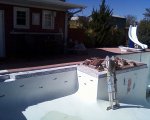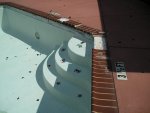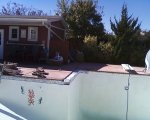Hey...newbie here..
My pool(38,000 gals) is eight years old now..... Two years ago the tiles began to pop off..About 50 of them(all 6 X 6 five piece tiles).
The pool was never caulked at the coping / Deck..However I did do it myself a few years ago after I had Cool deck applied...Which, BTW, led to the only time the deck has heaved in winter.
OK...here is my question... While removing all the tiles this year, and chipping the wall back to the shell, I have discovered that the coping is literally not even connected to the beam wall..( beam Wall is in great shape...)
You can see in my pictures that a lot of my coping was installed using what looks like Tile compound...I mean, Its white, not grey like morter mix(brixmix)..Some coping is adheared with the proper grey mix.
Is this improper to use on brick coping ?
As a result..I have decided to remove all the coping(most came off by hand alone) and replace it with stone..
The (white) mix used once the coping was removed was very flaky at best..
I realise that deck movement , due to lack of the expansion joint not sealed, may have caused some of this...But it seems to me that the white mastic should have never been used...
Some coping are still attached, and sound very solid, but most is loose.
Thanks ...(please see pictures for the areas where the coping was installed with Tile Mastic)
many thanks
BTW...My builder is going to come look at it...I would really like to know before hand if it was improperly done from day one...
My pool(38,000 gals) is eight years old now..... Two years ago the tiles began to pop off..About 50 of them(all 6 X 6 five piece tiles).
The pool was never caulked at the coping / Deck..However I did do it myself a few years ago after I had Cool deck applied...Which, BTW, led to the only time the deck has heaved in winter.
OK...here is my question... While removing all the tiles this year, and chipping the wall back to the shell, I have discovered that the coping is literally not even connected to the beam wall..( beam Wall is in great shape...)
You can see in my pictures that a lot of my coping was installed using what looks like Tile compound...I mean, Its white, not grey like morter mix(brixmix)..Some coping is adheared with the proper grey mix.
Is this improper to use on brick coping ?
As a result..I have decided to remove all the coping(most came off by hand alone) and replace it with stone..
The (white) mix used once the coping was removed was very flaky at best..
I realise that deck movement , due to lack of the expansion joint not sealed, may have caused some of this...But it seems to me that the white mastic should have never been used...
Some coping are still attached, and sound very solid, but most is loose.
Thanks ...(please see pictures for the areas where the coping was installed with Tile Mastic)
many thanks
BTW...My builder is going to come look at it...I would really like to know before hand if it was improperly done from day one...




